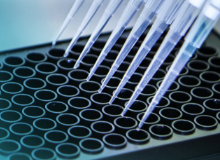Amplicon Sequencing
Amplicon sequencing is a next generation sequencing (NGS) technique used to detect low frequency variants, quantify mixed populations, and analyze multiple samples at scale.
We offer various solutions for ultra-deep amplicon sequencing of PCR products to validate and discover variations in specific genomic regions or screen clones. Our amplicon sequencing services employ the latest technologies for custom, in-depth analysis of amplicons ranging from 100 base pairs (bp) to >10,000 bp.
Applications for amplicon sequencing include antibody library screening, natural antibody repertoire profiling, disease genotyping, CRISPR mutation analysis, 16S and 18S amplicon sequencing, screening of molecular clones, and analysis of plasmid stocks.
Amplicon Sequencing Services
Multiple Solutions to Answer Every Biological Question
| GENEWIZ Service | Starting Material | Technology | Read Quality | Read Length | Reads / Read Depth | Automatic Assembly | Best For |
|---|---|---|---|---|---|---|---|
| Sanger Sequencing |
Purified or unpurified PCR product | Sanger | Higher Quality | <1000 bp | 1 – 4 | – |
|
| Amplicon-EZ |
Purified PCR product | Illumina® Short-read NGS | Best Quality | 150-500 bp | 50,000 Custom options available > |
Included |
|
| Long-Read Amplicon Sequencing |
Purified PCR product | PacBio® Long-read NGS | Best Quality | <25 kb* | 100,000 | Included |
|
*If you are sequencing larger than 25 kb amplicons, please submit an inquiry for a technical consultation.
What is amplicon sequencing?
Amplicon sequencing is a targeted sequencing method that uses polymerase chain reaction (PCR) to selectively amplify specific DNA fragments or genomic regions of interest. Specific primers are designed to flank the target region and the resulting amplicons are then sequenced to determine the nucleotide sequence.
What is the difference between targeted sequencing and amplicon sequencing?
Targeted sequencing and amplicon sequencing both selectively sequence specific regions of the genome, rather than the whole genome. However, the difference between the two methods lies in how the regions of interest are selected and amplified.
Targeted sequencing amplifies through hybridization capture and uses probes or baits complimentary to the target region in order to selectively capture and enrich for specific genomic regions, such as genes, exons, and other functional regions of the genome. Targeted sequencing often offers greater coverage than amplicon sequencing, as the use of hybridization capture can help mitigate biases in the representation of certain genomic regions.
Amplicon sequencing amplifies DNA fragments using PCR. The target regions are defined by PCR primers designed to anneal specific sequences that flank the areas of interest, initiating the amplification process of the targeted DNA fragments. Amplicon sequencing is often more cost-effective than targeted sequencing as it does not involve the use of capture reagents.
The GENEWIZ Difference
Technical Resources

Blog | NGS, PCR, or Sanger Sequencing: An Assay Selection Guide
This selection guide offers practical information about PCR + Sanger, qPCR, and NGS approaches to help you determine which assay best suits your project requirements, along with an interactive assay selection tool to aid your decision making.
Sample Submission Guidelines
GENEWIZ accepts purified and unpurified amplicons, restriction digested material, fragmented DNA, and plasmids. For detailed sample submission requirements please visit our Sample Submission Guidelines.
Deliverables
All customers receive their raw data as FASTQ files. Customizable data analysis packages are available by request.NGS PLATFORMS
For information on our NGS platforms as well as recommended configurations of your projects, please visit the NGS Platforms page. GENEWIZ from Azenta does not guarantee data output or quality for sequencing-only projects.




